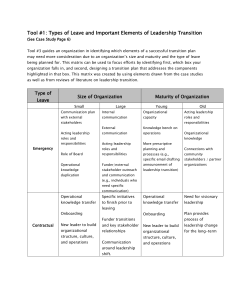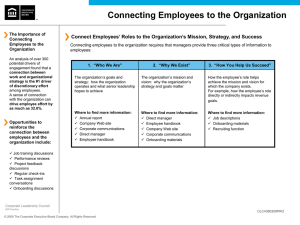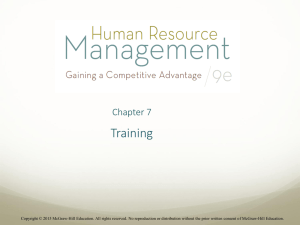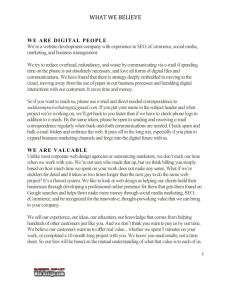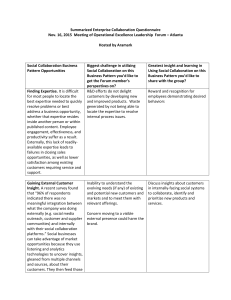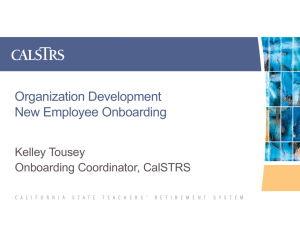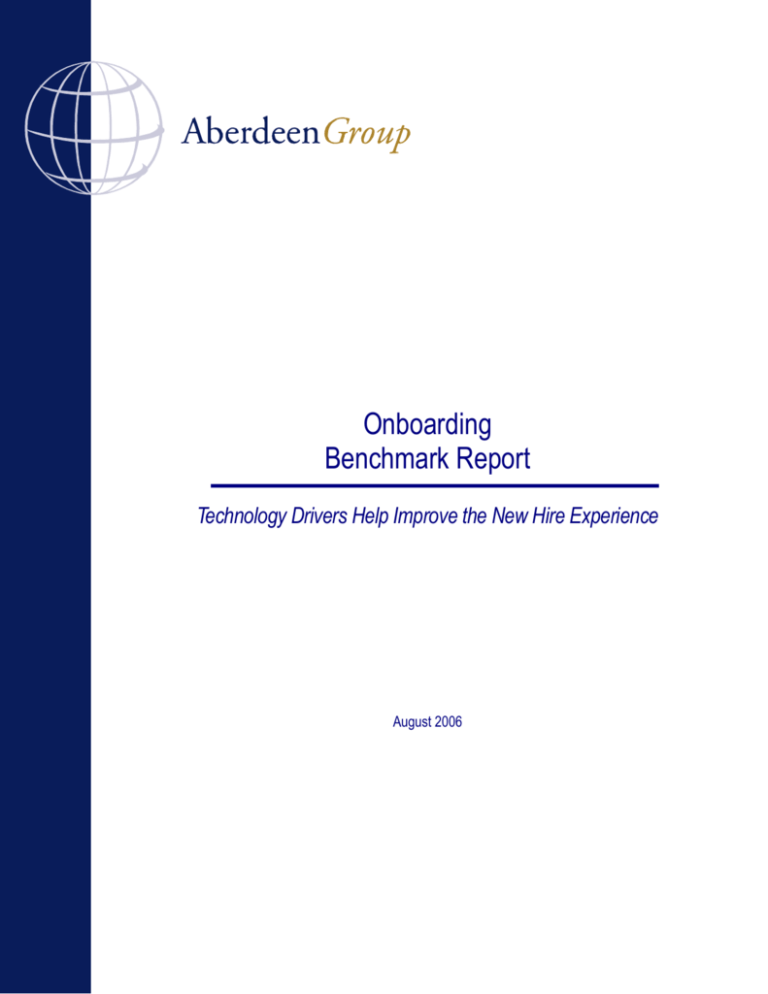
Onboarding
Benchmark Report
Technology Drivers Help Improve the New Hire Experience
August 2006
The Onboarding Benchmark Report
Executive Summary
Key Business Value Findings
First impressions last. Future-looking companies recognize that the first impression a
new hire makes of their work environment is critical to improving retention rates and
improving the company brand. A new employee that feels engaged in the company on
their first day of work will have a greater incentive to stay at that company. In today’s
environment, support for new hires is not only executed in the recruitment efforts but
more importantly, in a well defined, formalized on-boarding process.
Onboarding encompasses the variety of tasks and requirements involved with acclimating
and engaging a new employee in the company. Onboarding is no longer the new hire
“orientation” of the past. The checklists associated with onboarding have evolved into an
integrated experience. This report defines onboarding as a process involving: forms
management, tasks management, and socialization in the company culture. Companies
that incorporate these three components are those companies that will achieve optimal
ROI from their onboarding process. The data included in this report is derived from a
survey conducted in partnership with the Human Capital Institute and interviews with
senior executives in the human capital management community.
Implications & Analysis
Onboarding has gained momentum over the past year. Seventy-six percent of companies
are implementing or plan to implement a formalized process compared to only 40% in
2005. Despite this increase, many companies still do not grasp the fundamentals of onboarding. These companies face challenges defining the onboarding process and creating
an onboarding roadmap.
Although 90% of companies believe that their employees make their decision to stay at
the company within the first six months, many of these companies do not recognize or
acknowledge how onboarding impacts retention rates and time to productivity (Figure 1).
Instead, they rely on paper-based solutions that create added costs and often leave a bad
first impression that negatively affects the company brand. Thirty-six percent of companies still do not use any technology for their onboarding solution.
All print and electronic rights are the property of AberdeenGroup © 2006.
AberdeenGroup • i
The Onboarding Benchmark Report
Figure 1: Companies Believe the Following Strategies Influence Retention Rates
Compensation
Onboarding
Sourcing and Assessment
Hiring
Training and Development
Performance Management
Succession Planning
0%
5%
10%
15%
20%
25%
30%
Source: AberdeenGroup, August 2006
Best performing, future-looking companies distinguish themselves by extending onboarding to the first six months and leveraging technology to assist with forms management, tasks management, socialization, building a network, measuring performance and
compliance. Technology, however, is not the panacea for onboarding. Companies need to
look to the future by defining the onboarding process, creating an onboarding roadmap,
and investing in strategic long-term workforce planning that integrates their onboarding
with the pre-hire stages and the post-hire stages.
Recommendations for Action
In addition to the Best in Class actions, companies should also evaluate their processes to
ensure they effectively accomplish the following:
•
Define the onboarding process and create an onboarding roadmap
•
Integrate onboarding with the overall hiring management process
•
Extend onboarding to the first six months, the amount of time that an employee
makes his or her decision to stay at a company
•
Replace paper and spreadsheet based processes and use an automated system that
includes forms management, tasks management, and socialization in the company culture
•
Create an onboarding roadmap in order to establish a long-term strategic plan for
the onboarding process
•
Measure short-term retention rates and time to productivity
All print and electronic rights are the property of AberdeenGroup © 2006.
ii • AberdeenGroup
The Onboarding Benchmark Report
Table of Contents
Executive Summary .............................................................................................. i
Key Business Value Findings.......................................................................... i
Implications & Analysis ................................................................................... i
Recommendations for Action..........................................................................ii
Chapter One: Issue at Hand.................................................................................1
Chapter Two: Key Business Value Findings .........................................................5
Components of Onboarding .................................................................... 6
Challenges and Responses .................................................................... 7
Chapter Three: Implications & Analysis............................................................. 11
Process and Organization ........................................................................... 12
Technology Usage................................................................................. 14
Metrics .................................................................................................. 15
Pressures, Actions, Capabilities, Enablers (PACE)...................................... 17
Chapter Four: Recommendations for Action. ..................................................... 19
Laggard Steps to Success........................................................................... 19
Industry Average Steps to Success ............................................................. 19
Best in Class Next Steps ............................................................................. 20
Author Profile ..................................................................................................... 21
Appendix A: Research Methodology .................................................................. 22
Appendix B: Related Aberdeen Research & Tools ............................................. 25
About AberdeenGroup ...................................................................................... 26
All print and electronic rights are the property of AberdeenGroup © 2006.
AberdeenGroup
The Onboarding Benchmark Report
Figures
Figure 1: Companies Believe the Following Strategies Influence Retention Ratesii
Figure 2: Talent Acquisition Processes.................................................................2
Figure 3: Timeframe an Employee Makes a Decision to Stay at a Company.......2
Figure 4: Top Pressures for Onboarding ..............................................................4
Figure 5: Companies that have Implemented a Formalized Process ...................5
Figure 6: Top Challenges for Onboarding.............................................................6
Figure 7: Top Challenges for Onboarding.............................................................7
Figure 8: Process for Onboarding ...................................................................... 13
Figure 9: Timeframe that Best in Class companies extend Onboarding............. 13
Figure 10: Technology Used for Onboarding...................................................... 14
Figure 11: Key Performance Indicators Measured ............................................. 16
Figure 12: Strategies the Have the Greatest Impact on Retention Rates........... 17
Tables
Table 1: Onboarding Challenges and Responses ................................................8
Table 2: Onboarding Competitive Framework .................................................... 12
Table 3: Onboarding Technology Investments in Next 12-24 Months................. 15
Table 4: PACE (Pressures, Actions, Capabilities, Enablers)............................... 18
Table 5: PACE Framework ................................................................................. 23
Table 6: Competitive Framework........................................................................ 24
All print and electronic rights are the property of AberdeenGroup © 2006.
AberdeenGroup
The Onboarding Benchmark Report
Key Takeaways
Chapter One:
Issue at Hand
• Ninety percent of employees make their decision to stay at a company within the first six
months.
• Onboarding is gaining steam: in 2005, 60% of companies did NOT have a formalized onboarding process compared to 24% today
• The top pressures to implement an automated onboarding process include: improving
time to productivity, improving retention rates and improving customer satisfaction
T
he buzzword for human capital management today is onboarding. Onboarding is
a support process for new employees designed to manage a variety of tasks and
requirements initiated when a new applicant is hired and has accepted the position. New employees often feel that the attention they receive during the pre-hire
stages is abandoned once they are onboard. As a result, these individuals are left with a
negative impression of their new work environment. In order to improve retention rates
and time to productivity, companies need to focus on developing a comprehensive onboarding process.
Competitive Framework
Key
Companies that develop strategies for identifying, attracting
and engaging top talent recognize that their greatest asset is The Aberdeen Competitive
their workforce. Aberdeen’s latest report, Talent Acquisition Framework defines enterStrategies: Sourcing and Assessing the Best of the Best, prises as falling into one of
states that companies are investing in sourcing and assess- the three following levels of
ment over any other process of talent acquisition. (See Fig- practices and performance:
ure 2)
Laggards (30%) —practices
Although sourcing and assessment strategies enable compa- that are significantly behind
nies to identify and attract the right people for the right jobs, the average of the industry
the key to employee engagement is found in a formalized,
well-defined onboarding process. By investing in onboard- Industry average (50%) —
ing, these companies are investing in the future workforce of practices that represent the
their company. Ninety percent of employees make their de- average or norm
cision to stay at a company within the first six months ( Best in class (20%) —
Figure 3).
practices that are the best
currently being employed
and significantly superior to
the industry norm
All print and electronic rights are the property of AberdeenGroup © 2006.
AberdeenGroup • 1
The Onboarding Benchmark Report
Figure 2: Talent Acquisition Processes
9%
14%
13%
36%
28%
Planning
Sourcing
Assessing
Hiring
On-boarding
Source: AberdeenGroup, August 2006
Figure 3: Timeframe an Employee Makes a Decision to Stay at a Company
The first day
The first week
The first month
The first six months
The first year
The first two years
The first five years
Other
0%
10%
20%
30%
40%
Source: AberdeenGroup, August 2006
How effective a company is at its onboarding process determines how successful that
company is at retaining its employees, yet, many companies do not recognize this connection. Although the majority of companies believe their employees make their decision
to stay at the company within the first six months, only 15% of companies extend their
onboarding solution for the first six months. Twenty-three percent extend onboarding in
the first day, 28% in the first week, and 22% in the first month.
All print and electronic rights are the property of AberdeenGroup © 2006.
2 • AberdeenGroup
The Onboarding Benchmark Report
PACE Key — For more detailed description see Appendix A
Aberdeen applies a methodology to benchmark
research that evaluates the business pressures,
actions, capabilities, and enablers (PACE) that
indicate corporate behavior in specific business
processes. These terms are defined as follows:
Pressures — external forces that impact an
organization’s market position, competitiveness, or business operations
Actions — the strategic approaches that an
organization takes in response to industry
pressures
Capabilities — the business process
competencies required to execute
corporate strategy
Enablers — the key functionality
of technology solutions required to support the organization’s enabling business practices
In order for employees to feel engaged and
acclimated in the company, onboarding needs
to be proactive and clearly defined. As companies look to improve their new hire experience, they are researching and investing in
technology to enable their new hires to have
a smoother transition from the recruitment
stages. Automated solutions can help companies address pressures to improve retention
rates, improve time to productivity and improve the company brand (Figure 4). Additional pressures include eliminating extra
costs, facilitating the forms process and improving customer satisfaction. These pressures reveal future-looking, long-term strategies that affect the needs of both the organization and the employee.
All print and electronic rights are the property of AberdeenGroup © 2006.
AberdeenGroup • 3
The Onboarding Benchmark Report
Figure 4: Top Pressures for Onboarding
70%
60%
60%
53%
52%
50%
40%
41%
31%
28%
30%
20%
10%
0%
Eliminate the extra
costs of a paper
based process
Improve retention
rates
Facilitating the
management and
collection of forms
Improve time to
productivity
Improve company
brand
Source: AberdeenGroup, August 2006
All print and electronic rights are the property of AberdeenGroup © 2006.
4 • AberdeenGroup
Improve overall
customer
satisfaction
The Onboarding Benchmark Report
Key Takeaways
Chapter Two:
Key Business Value Findings
• A robust onboarding program includes three key areas: forms management, tasks management, and socialization in the company culture
• The major challenges for implementing an onboarding strategy include: defining the onboarding process, integrating onboarding into the hiring management system and viewing onboarding as a checklist instead of an integrated experience
• The top three responses include: creating a roadmap, ensuring that the new hire has a
positive experience and integrating with the hiring management system
An effective onboarding process can transform a new hire into a dedicated employee,
eliminating the cost of turnover. Visibility around onboarding has increased over the past
few years and is now a crucial step for any talent acquisition strategy. In 2005, nearly
60% of companies did not implement or did not plan to implement an onboarding initiative. Today, this number has decreased dramatically and only 24% of companies do not
implement or do not plan to implement a formalized onboarding process (Figure 5).
Figure 5: Companies that have Implemented a Formalized Process
11%
7%
24%
No completed or planned
activity
None. But budgeted to
start within 12 months
More than 12 months
12%
6 to 12 months
Less than 6 months
46%
Source: AberdeenGroup, August 2006
Despite the hype around onboarding, few companies are acting strategically and planning
ahead. Seventy-one percent of companies still have a reactive; emergency-driven process
with no or little planning. Onboarding becomes effective when companies create an onboarding roadmap with several tasks, including providing a new hire with equipment to
assigning a mentor. Companies have identified the following tasks as necessary for an
effective onboarding process. (Figure 6)
All print and electronic rights are the property of AberdeenGroup © 2006.
AberdeenGroup • 5
The Onboarding Benchmark Report
Figure 6: Top Challenges for Onboarding
70%
60%
50%
40%
30%
20%
59%
49%
53%
47%
27%
12%
10%
0%
Provide new
hires with
equipment
and supplies
Ensure that
all forms are
processed
correctly
Provide
information
about the
company
culture
Assign
mentor
Manager
schedules a
dialogue with
new employee
Welcome
lunch
Source: AberdeenGroup, August 2006
Components of Onboarding
These requirements for a new hire fall under three categories: forms management, tasks
management and socialization in the company culture. While a large percentage of companies are using forms management, tasks management and socialization are still new
and not every company has incorporated these components into their process. Eightyfour percent of companies use forms management, 66% use tasks management and 74%
use socialization in the company culture.
Forms Management: Includes all of the new hire data and electronic completion and
tracking of forms in order to eliminate the inefficiency, cost and lack of timeliness with
paper-based form completion. Technology that enables forms management can include
tools to automate the completion of candidate forms both before they start and on the first
day.
Tasks Management: Involves the workflow tasks including the notification and tracking of activities required to prepare for a new hire. An example of technology that enables task management includes automated requests and reminders that notify the individual of the needs of the employee.
Socialization: Involves the delivery of information about the culture and history of the
company. Although not every solution offers this component, it is critical to making employees feel more engaged and connected to the organization. An example of the technology that enables socialization includes new hire portals.
All print and electronic rights are the property of AberdeenGroup © 2006.
6 • AberdeenGroup
The Onboarding Benchmark Report
Challenges and Responses
The concept seems simple: develop a support system for your new employees that includes forms management, tasks management and socialization in the company culture.
Onboarding affects every employee and is at the forefront of most human capital agendas. So, why are companies still struggling to implement a way to improve the new hire
experience?
Companies face several challenges in onboarding including complete integration and
rapid start-up to full-productivity of new hires, defining the onboarding process, and
viewing onboarding as a checklist. Companies also face challenges in handing off the
new employee from the recruiting manager to the hiring manager. One company stated
that their challenge was finding a solution that would cater to both their exempt and nonexempt employees, since 70% of their employees are non-exempt employees. These challenges reveal that onboarding is in the early stages and requires companies to make onboarding a commitment.
Figure 7: Top Challenges for Onboarding
70%
60%
50%
40%
30%
20%
10%
0%
Lack of
robust
onboarding
process
Onboarding is Onboarding is
not made a
viewed as a
priority
checklist
BIC
Industry Average
Defining the
onboarding
experience
Unclear
ownership of
the
onboarding
process
Laggard
Source: AberdeenGroup, August 2006
Best-performing companies are responding to these challenges by creating an onboarding
roadmap, emphasizing strategic long-term workforce planning and ensuring that their
employees have a positive experience after joining the organization. Best in Class companies have been successful at defining the onboarding process but still need improvements for taking these basic steps to the next level by establishing clear ownership and
integrating onboarding with the hiring management process.
All print and electronic rights are the property of AberdeenGroup © 2006.
AberdeenGroup • 7
The Onboarding Benchmark Report
Table 1: Onboarding Challenges and Responses
Challenges
% Selected
Responses to Challenges
% Selected
1. Onboarding is viewed as a checklist instead of an integrated experience
60%
1. Ensure and check to verify that
employees have a positive experience after joining the organization
57%
2. Lack of robust onboarding process
for complete integration and rapid
start-up to full productivity of new hires
53%
2. Create an onboarding road map
52%
3. Onboarding is not made a priority
41%
3. Integrate onboarding with hiring
management process
44%
4. Defining the onboarding process
37%
4. Emphasize strategic long-term
workforce planning
28%
5. Unclear ownership of onboarding
tasks between human resources staff
and hiring managers
37%
5. Automate the tasks of the onboarding process
27%
6. Inadequate prediction or planning of
future workforce
24%
6. Use tools and technology to help
with building a network for the new
hire
23%
Source: AberdeenGroup, August 2006
All print and electronic rights are the property of AberdeenGroup © 2006.
8 • AberdeenGroup
The Onboarding Benchmark Report
Key Takeaways
Chapter Three:
Implications & Analysis
•
Nearly 30% of Best in Class companies extend onboarding to the first six months compared to less than 10% of Laggard companies
•
Fifty-five percent of Best in Class companies have a manager responsible for the onboarding process compared to 39% of Laggard companies
•
Ninety percent of Best in Class companies incorporate socialization compared to 75% of
Laggard companies
•
Fifty-six percent of Best in Class companies have a reactive, emergency-driven process
compared to 91% of Laggard companies
Aberdeen’s competitive framework, used in its corporate comparison benchmarking, distinguishes between Laggards, the Industry Average, and Best in Class on the basis of increased retention rates and improved time to productivity (Table 2). Best in Class companies were defined as those companies that experienced an increase in retention rates
over 20% and increase in time to productivity over 20%. Best in Class companies are
those companies that are looking to the future. They are responding to top challenges by
defining the onboarding process and creating a roadmap for onboarding. These companies are taking action to automate their onboarding process to enable forms management,
tasks management and socialization.
Retention rates and time to productivity for Industry Average companies remained the
same or increased below 20%. Laggard companies are those companies that experienced
a decrease in retention rates and time to productivity. These companies do not transform
their perspective on onboarding or recognize the ROI of a formalized process.
One Best in Class company stated that when selecting their technology solution, they
were looking for a rigorous process that included a personalized portal for socialization,
forms management and tasks management. In the onboarding process, there are several
distinguishing factors between Best in Class companies and Laggards that are enabled by
technology:
•
49% of Best in Class companies feel pressure to improve the company brand
compared to 21% of Laggards
•
60% of Best in Class companies had an increase in retention rates compared to
30% of Laggard companies
•
65% of Best in Class cited that time to productivity has the biggest impact on
onboarding compared to 18% of Laggards
•
56% are interested in improving overall customer satisfaction compared to 32%
of Laggards
All print and electronic rights are the property of AberdeenGroup © 2006.
AberdeenGroup • 11
The Onboarding Benchmark Report
Table 2: Onboarding Competitive Framework
Laggards
Industry Average
Best in Class
Process
•
Reactive; emergency driven; no or
little planning
•
An independent
process, not aligned
with the overall hiring management
process
•
A holistic approach
to onboarding, a
strategic plan that
looks at onboarding
as an experience
for both the organization and the employee
Organization
•
Have not adopted a
talent mindset and
still do not view
employees as assets
•
Working on investing in strategies to
view employees as
assets
•
View their employees as assets and
adopted a talent
mindset
Knowledge
•
Adopted only forms
management
•
Adopted a combination of forms management and tasks
management
•
Adopted a greater
combination of
forms management,
tasks management
and socialization
Technology
•
Paper-based process for forms management
•
Paper-based process with some automation for forms
management and
tasks management
•
Technology used for
forms management,
tasks management
and socialization
Source: AberdeenGroup, August 2006
Process and Organization
Onboarding is a relatively new phenomenon in the world of human capital management
and as a result, companies are not up to speed in their onboarding process. Companies
still need to transition their onboarding process from a checklist to an experience in order
to acclimate and engage their employees. Seventy-one percent of companies still have a
reactive; emergency-driven onboarding process with little or no planning. Eighteen percent of Best in Class companies are taking active steps to make onboarding more of a
holistic experience compared to only 4% of Laggard companies.
All print and electronic rights are the property of AberdeenGroup © 2006.
12 • AberdeenGroup
The Onboarding Benchmark Report
Figure 8: Process for Onboarding
BIC
Industry Average
Laggard
0%
20%
Holistic approach
40%
Independent process
60%
80%
100%
Reactive; emergency driven
Source: AberdeenGroup, August 2006
A positive step towards creating a holistic experience is by extending the onboarding
process to the first six months, the time period that an employee makes the decision
to stay at the company, as opposed to the first day, the first week or the first month.
(Figure 9)
Figure 9: Timeframe that Best in Class companies extend Onboarding
The first day
the first week
The first month
The first six months
The first year
Other
0%
10%
BIC
20%
Industry Norm
30%
40%
Laggard
All print and electronic rights are the property of AberdeenGroup © 2006.
AberdeenGroup • 13
The Onboarding Benchmark Report
Technology Usage
Although technology creates efficiency, cuts costs and reduces turnover, it is not the
magic wand for onboarding. As one customer stated in their search for the right technology solution, they were looking for technology that would “help prompt managers to do
things and also has some sort of checks and balances in place but overall the basics for
onboarding and a commitment to the experience need to be in place first.” The technology will offer a variety of benefits but the software is so new that not every company is
making this investment. Companies identified the top three pressures for using technology:
•
Improving time to productivity
•
Improving overall customer satisfaction
•
Desire to improve retention rates
Despite these pressures, 36% of companies do not use any technology. They might use
technology for certain aspects of the new hire experience but they do not establish a
process or they often develop in-house tools that are impersonal.
When investing in technology, end-users can choose a solution that is integrated with an
existing ATS vendor or a stand-alone solution. During interviews with end-users looking
to invest in onboarding, the majority stated that they are not always looking at their current ATS vendor for onboarding but would like onboarding to “interface with their current ATS.” Both options have advantages, but finding the right solution depends on several factors based on the specific needs of the organization (Figure 10).
Figure 10: Technology Used for Onboarding
45%
40%
35%
30%
25%
20%
15%
10%
5%
0%
41%
36%
25%
24%
23%
17%
12%
Forms
management
Tasks
management
Socialization
B uilding a
Measure the Compliance
network with performance of
other people in employees
the
organization
None of the
above
Source: AberdeenGroup, August 2006
All print and electronic rights are the property of AberdeenGroup © 2006.
14 • AberdeenGroup
The Onboarding Benchmark Report
The above tools fall under the three categories of onboarding: forms management, tasks
management and socialization. While the majority of companies are investing in forms
management, they have not yet recognized the importance of socialization in the company culture, found in such tools as new hire portals. Compliance tools are a necessity for
many companies looking to invest in an automated onboarding process to ensure that
government forms are filled out accurately and on-time.
Table 3: Onboarding Technology Investments in Next 12-24 Months
Technology Solution Area
% Selected
Tools to automate the candidate communication
29%
Technology that notifies the individual of the needs of new
employees
22%
Tools that automate the forms process of onboarding
32%
Technology that relies on data used during the recruiting
stages
27%
Reporting tools to track the progress in getting the new hire up
to speed
25%
Personalized portal for employees
36%
Source: AberdeenGroup, Month 2006
Metrics
Companies have not only identified time to productivity and retention rates as top pressures for an automated onboarding process but also as the key performance indicators
that would have the greatest impact on their organization. Companies identified retention
rates and time to productivity over completion rates for onboarding and time for receiving equipment and supplies. These metrics are critical to determining if a new hire is the
right hire and whether the energy and cost spent in the pre-hire stages achieve positive
results. Although companies understand the value of these KPIs, they do not always
measure them ( Figure 11).
All print and electronic rights are the property of AberdeenGroup © 2006.
AberdeenGroup • 15
The Onboarding Benchmark Report
Figure 11: Key Performance Indicators Measured
40%
35%
30%
25%
20%
15%
10%
5%
0%
Time to
productivity
Time to
receiving
equipment
and tools
Time to
completing
training
First -year
retention
rates
Completion
rate for onboarding
tasks
Source: AberdeenGroup, August 2006
Without these metrics, companies will have no way to measure if their onboarding process positively affects their organization.
•
Thirty-four percent of Best in Class companies measure retention rates compared
to 22% of Laggard companies.
•
At the same time, 65% recognize that time to productivity would have the greatest impact on implementing onboarding but only 34% track it.
•
Fifty-five percent of Laggard companies recognize that retention rates would
have the biggest impact on onboarding but only 40% measure it.
Companies are not always recognizing the correlation between the treatment of a new
hire and improved ROI. Companies still cite succession planning and training as having a
greater impact on retention rates than onboarding (Figure 12).
All print and electronic rights are the property of AberdeenGroup © 2006.
16 • AberdeenGroup
The Onboarding Benchmark Report
Figure 12: Strategies the Have the Greatest Impact on Retention Rates
Compensation
Onboarding
Sourcing and Assessment
Hiring
Training and Development
Performance Management
Succession Planning
0%
5%
10%
15%
20%
25%
30%
Source: AberdeenGroup, August 2006
Pressures, Actions, Capabilities, Enablers (PACE)
This report outlines the clear relationship between the pressures companies identify and
the actions they take, and their subsequent competitive performance. All participants
should examine their prioritized PACE selections and determine whether there are valuable perspectives to be gleaned by comparison with the PACE priorities of Best in Class
companies.
Why is onboarding receiving so much attention today? As companies develop a talent
perspective, they recognize onboarding as the link for companies looking to identify and
retain top talent. In order to compete in the “war for talent”, companies can strengthen
their company brand by making a good first impression to their talent. Efforts can no
longer stop at the recruiting stages; it needs to extend to the first day of work and beyond.
In response to these external forces, future-looking companies are looking to improve
time to productivity, retention rates and improving employee engagement. Once companies have defined onboarding and created a roadmap, automation allows them to offer a
way to integrate their process with the hiring management process and incorporate forms
management, tasks management and socialization.
All print and electronic rights are the property of AberdeenGroup © 2006.
AberdeenGroup • 17
The Onboarding Benchmark Report
Table 4: PACE (Pressures, Actions, Capabilities, Enablers)
Prioritized
Pressures
Prioritized
Actions
Prioritized
Capabilities
Prioritized
Enablers
1
Improve retention
rates
Invest in a robust, formalized
onboarding
process that is
integrated with
the hiring management process
Measure retention rates
Automated onboarding
process that includes forms
management, tasks management and socialization
2
View onboarding
as an integrated
experience and
not a checklist
Drive an onboarding mindset starting at
the top of the
organization
Incorporate
forms management,
tasks management, and
socialization
New hire portal that replaces impersonal inefficient paper system
3
Improving the
company brand
Invest in engaging employees
beyond the prehire stages
Robust onboarding
process
Automated onboarding
process that leaves employees with a positive
first impression of the company
4
Improve time to
productivity
Enable the new
hires with the
equipment and
tools in the prehire stages
Focus on
forms management completion before
the employee
starts
Technology to assist with
completing forms to meet
compliance and efficiency
Priorities
Source: AberdeenGroup, Month 2006
All print and electronic rights are the property of AberdeenGroup © 2006.
18 • AberdeenGroup
The Onboarding Benchmark Report
Key Takeaways
Chapter Four:
Recommendations for Action.
•
Companies should not look to technology to save their onboarding process, they need
to first define the process and create an onboarding roadmap
•
Companies looking to develop a formalized onboarding solution need to integrate this
solution with the hiring management process
•
To improve retention rates and time to productivity, companies will benefit from automating their onboarding process.
•
C
ompanies that invest in a formalized onboarding process will have improved
company brand, reduce the cost of turnover and increase time to productivity. In
order to make a good first impression, companies need to invest in their employees beyond the pre-hire stages. They need to develop an onboarding process that will acclimate their employees and strengthen their company brand.
Whether a company is trying to gradually move its onboarding process from “Laggard”
to “Industry Average” to “Best in Class,” the following actions will help spur the necessary performance improvements:
Laggard Steps to Success
1. Integrate onboarding with the hiring management process
Laggard companies fail to integrate onboarding with the hiring management
process and as a result, these companies will have no way to hand off the onboarding process from the recruiting stages to the hiring stages.
2. Adopt a long-term approach to onboarding
Many companies fall short of Best in Class companies because they view onboarding as a checklist instead of an integrated experience. In addition, these
companies do not recognize the connection with onboarding and improving the
company brand.
3. Define the onboarding process
Companies need to establish the basics by defining what their onboarding process will include and also create a roadmap that will enable their process to have
greater consistency and efficiency.
Industry Average Steps to Success
1. Develop a formalized onboarding process
All print and electronic rights are the property of AberdeenGroup © 2006.
AberdeenGroup • 19
The Onboarding Benchmark Report
In order to leave a positive first impression on their employees, companies need a
well-defined, formalized onboarding process. These companies need to move
away from a reactive, emergency-driven approach of the past
2. Measure first year retention rates and time to performance
Companies recognize that retention rates and time to productivity are their top
pressures but few companies actually measure these key performance indicators.
By measuring these KPIs, companies will recognize the ROI in their onboarding
process.
3. Eliminate paper- and spreadsheet-based processes, and consider Web-based
technology solutions.
An automated solution can help pull information from an existing ATS system,
notify the necessary departments and provide the new hire with information
about forms management, tasks management and socialization. One end-user
stated that the solution made life easier and was very “responsive and reliable.”
Best in Class Next Steps
1. Measure first-year retention rates and time to performance
These are not only the key performance indicators measured but they are also the
top pressures that companies feel for investing in an automated onboarding process.
2. Automate every component of onboarding including forms management, tasks
management and socialization in the company culture
An automated process can help ensure that all three of these components are accounted for, in addition to building a network, compliance and measuring performance. Technology will also reduce costs, reduce turnover and create a faster
start time.
.
All print and electronic rights are the property of AberdeenGroup © 2006.
20 • AberdeenGroup
The Onboarding Benchmark Report
Author Profile
Madeline Tarquinio
Research Analyst
Human Capital Management
AberdeenGroup, Inc.
As a research analyst for the Human Capital Management division of Aberdeen, Madeline Tarquinio will focus her research on the employee life cycle, including candidate
recruiting, performance management, assessment, career development and retention.
Prior to joining Aberdeen, Tarquinio worked as the head of research at Linkage, Inc. She
created best practice publications around areas such as succession planning, global workforce management, and action learning. She helped create an on-line toolkit for developing leaders and is the co-editor of two books published by Jossey-Bass, Leading the
Global Workforce and Secrets of Succession Planning (to be published in 2006). Her experience editing, writing and publishing work in this field has given her a wide range of
knowledge on issues related to human resources and organizational development.
Tarquinio holds a bachelor’s degree and a master’s degree in international relations from
Boston University.
All print and electronic rights are the property of AberdeenGroup © 2006.
AberdeenGroup • 21
The Onboarding Benchmark Report
Appendix A:
Research Methodology
B
etween July and August 2006, AberdeenGroup and Human Capital Institute examined the onboarding procedures, experiences, and intentions of more than 600
enterprises in aerospace and defense (A&D), automotive, high-tech, industrial
products, and other industries.
Responding senior executives, HR Generalists and VP’s of staffing and recruiting completed an online survey that included questions designed to determine the following:
•
The pressures, actions and capabilities companies face in improving their new
hire experience
•
The structure and effectiveness of existing onboarding procedures
•
Current and planned use of automation to aid these activities
•
The benefits, if any, that have been derived from aftermarket and onboarding initiatives
Aberdeen supplemented this online survey effort with telephone interviews with select
survey respondents, gathering additional information on onboarding strategies, experiences, and results.
The study aimed to identify emerging best practices for onboarding and provide a framework by which readers could assess their own onboarding capabilities.
Responding enterprises included the following:
•
Job title/function: The research sample included respondents with the following
job titles: senior management (44%); Manager (13%); CIO/IT manager (10%);
HR Director (3%), and Organizational Development Manager(2%).
•
Industry: The research sample included respondents from a variety of industries.
Automotive manufacturers represented 14% of the sample and aerospace, which
accounted for 17% of respondents. Chemicals totaled 9 % of respondents. Construction and Consumer durable goods accounted for 6% of the sample. Other
sectors responding included medical equipment, education, and retail and distribution.
•
Geography: Nearly all study respondents (55%) were from North America. Remaining respondents were from the United Kingdom and the Asia-Pacific region.
•
Company size: About 37% of respondents were from large enterprises (annual
revenues above US$1 billion); 29% were from midsize enterprises (annual revenues between $50 million and $1 billion); and 34% of respondents were from
small businesses (annual revenues of $50 million or less).
Solution providers recognized as sponsors of this report were solicited after the fact and
had no substantive influence on the direction of the Onboarding Benchmark Report.
All print and electronic rights are the property of AberdeenGroup © 2006.
22 • AberdeenGroup
The Onboarding Benchmark Report
Their sponsorship has made it possible for AberdeenGroup and Human Capital Institute
to make these findings available to readers at no charge.
Table 5: PACE Framework
PACE Key
Aberdeen applies a methodology to benchmark research that evaluates the business pressures, actions,
capabilities, and enablers (PACE) that indicate corporate behavior in specific business processes. These
terms are defined as follows:
Pressures — external forces that impact an organization’s market position, competitiveness, or business
operations (e.g., economic, political and regulatory, technology, changing customer preferences, competitive)
Actions — the strategic approaches that an organization takes in response to industry pressures
(e.g., align the corporate business model to leverage industry opportunities, such as product/service
strategy, target markets, financial strategy, go-to-market, and sales strategy)
Capabilities — the business process competencies required to execute corporate strategy
(e.g., skilled people, brand, market positioning, viable products/services, ecosystem partners,
financing)
Enablers — the key functionality of technology solutions required to support the organization’s enabling business practices (e.g., development platform, applications, network connectivity, user interface, training and support, partner interfaces, data cleansing, and management)
Source: AberdeenGroup, Month 2006
All print and electronic rights are the property of AberdeenGroup © 2006.
AberdeenGroup • 23
The Onboarding Benchmark Report
Table 6: Relationship between PACE and Competitive Framework
PACE and Competitive Framework How They Interact
Aberdeen research indicates that companies that identify the most impactful pressures and take the most
transformational and effective actions are most likely to achieve superior performance. The level of competitive performance that a company achieves is strongly determined by the PACE choices that they make
and how well they execute.
Source: AberdeenGroup, Month 2006
Table 6: Competitive Framework
Competitive Framework Key
The Aberdeen Competitive Framework defines enterprises as falling into one of the three following levels of
Onboarding practices and performance:
Laggards (30%) —Onboarding practices that are significantly behind the average of the industry, and result
in below average performance
Industry norm (50%) — Onboarding practices that represent the average or norm, and result in average
industry performance.
Best in class (20%) — Onboarding practices that are the best currently being employed and significantly
superior to the industry norm, and result in the top industry performance.
Source: AberdeenGroup, Month 2006
All print and electronic rights are the property of AberdeenGroup © 2006.
24 • AberdeenGroup
The Onboarding Benchmark Report
Appendix B:
Related Aberdeen Research & Tools
Related Aberdeen research that forms a companion or reference to this report includes:
•
Enterprise Talent Management (March 2005)
•
Talent Acquisition Strategies: Sourcing and Assessing the Best of the Best (June
2006)
Information on these and any other Aberdeen publications can be found at
www.Aberdeen.com.
All print and electronic rights are the property of AberdeenGroup © 2006.
AberdeenGroup • 25
The Onboarding Benchmark Report
About
Aberdeen Group
Our Mission
To be the trusted advisor and business value research destination of choice for the Global
Business Executive.
Our Approach
Aberdeen delivers unbiased, primary research that helps enterprises derive tangible business value from technology-enabled solutions. Through continuous benchmarking and
analysis of value chain practices, Aberdeen offers a unique mix of research, tools, and
services to help Global Business Executives accomplish the following:
•
IMPROVE the financial and competitive position of their business now
•
PRIORITIZE operational improvement areas to drive immediate, tangible value
to their business
•
LEVERAGE information technology for tangible business value.
Aberdeen also offers selected solution providers fact-based tools and services to empower and equip them to accomplish the following:
•
CREATE DEMAND, by reaching the right level of executives in companies
where their solutions can deliver differentiated results
•
ACCELERATE SALES, by accessing executive decision-makers who need a solution and arming the sales team with fact-based differentiation around business
impact
•
EXPAND CUSTOMERS, by fortifying their value proposition with independent
fact-based research and demonstrating installed base proof points
Our History of Integrity
Aberdeen was founded in 1988 to conduct fact-based, unbiased research that delivers
tangible value to executives trying to advance their businesses with technology-enabled
solutions.
Aberdeen's integrity has always been and always will be beyond reproach. We provide
independent research and analysis of the dynamics underlying specific technologyenabled business strategies, market trends, and technology solutions. While some reports
or portions of reports may be underwritten by corporate sponsors, Aberdeen's research
findings are never influenced by any of these sponsors.
All print and electronic rights are the property of AberdeenGroup © 2006.
26 • AberdeenGroup
The Onboarding Benchmark Report
AberdeenGroup, Inc.
260 Franklin Street, Suite 1700
Boston, Massachusetts
02110-3112
USA
Telephone: 617 723 7890
Fax: 617 723 7897
www.aberdeen.com
© 2006 AberdeenGroup, Inc.
All rights reserved
Month 2006
Founded in 1988, AberdeenGroup is the technologydriven research destination of choice for the global
business executive. AberdeenGroup has over 100,000
research members in over 36 countries around the world
that both participate in and direct the most comprehensive technology-driven value chain research in the
market. Through its continued fact-based research,
benchmarking, and actionable analysis, AberdeenGroup
offers global business and technology executives a
unique mix of actionable research, KPIs, tools,
and services.
The information contained in this publication has been obtained from sources Aberdeen believes to be reliable, but
is not guaranteed by Aberdeen. Aberdeen publications reflect the analyst’s judgment at the time and are subject to
change without notice.
The trademarks and registered trademarks of the corporations mentioned in this publication are the property of their
respective holders.

